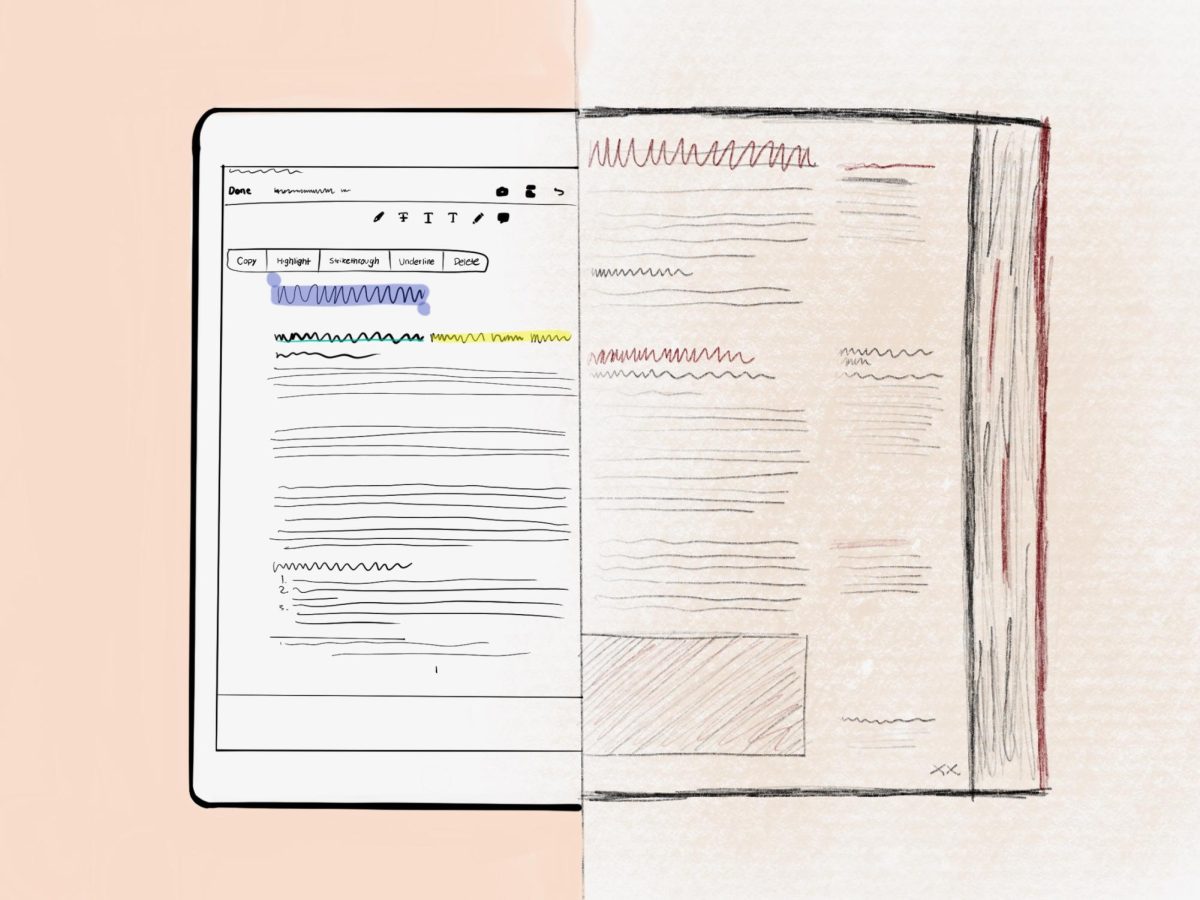
Within education, the medium of learning materials is central to the learning process. As digital texts become much more prevalent, the decisions teachers make in choosing these mediums are brought into question due to the possible impact they might have on students’ abilities to learn and retain information. Especially after the COVID-19 pandemic, with many teachers assigning classwork on Google Classroom and Jupiter Ed, students usually do not have a choice but to use a digital device to complete their assignments. This shift has opened up conversation surrounding the accessibility of online resources versus the familiarity of physical resources.
The use of textbooks varies amongst students. Some may use them to study and brush up on previous material, but of those interviewed, most used them primarily for mandatory assignments. Junior Valerie Villalba said, “I only use my textbook to do assignments, but I’m sure it can be a helpful way of studying as well.”
Junior Angela Yang said she uses the textbook when her “teacher assigns reading pages [and] then [uses] the textbook to complete that homework.” She continued, “I don’t really use it to study other than to review some material for upcoming tests.”
The advantages of using digital textbooks include that they are more environmentally friendly compared to traditional textbooks, can easily be accessed from anywhere, and may have interactive content like videos and/or practice problems.
Students mentioned that their preference for digital textbooks is particularly due to their accessibility. Angela said, “[digital textbooks are] more accessible because I can open it at any location as long as I have my laptop.” Similarly, Sophomore Anita Mei said, “…it’s easy to access and I won’t need to carry around a big book.”
Using physical textbooks has its advantages too; some prefer the feeling of flipping through pages and some find them easier on the eyes.
Science teacher Katherine Cooper said, “[Digital resources create] potential for high eye strain because when you are looking at an electronic screen you [experience] blue light issues.”
Valerie said, “I’d prefer to have a physical copy of my textbook because that’s the style I’m used to. It’s a bit hard to manage with a device like an iPad, but that’s just me, because I’m not used to that sort of thing.”
Another factor to consider is that students using devices in class to open a textbook or PDF may become distracted by the multitude of applications available.
Freshman Yassin Elabidi said, “Once the pandemic ended, many of my teachers more frequently used digital resources for classwork and homework. The use of devices in class can sometimes be distracting because it is very easy to redirect my attention to something that is not school-related. I use devices for the majority of my classes, and sometimes, by the end of the day, my eyes will be a little worn out due to prolonged exposure to screens.”
In terms of how the medium of textbooks specifically impacts students’ learning, several studies have been released showing each of their effectiveness through a scientific lens.
According to research published by Science Direct: “The results indicated that students who used e-textbooks for their education courses had significantly higher perceived psychomotor and affective learning than students who choose to use traditional print textbooks.” The term ‘psychomotor’ refers to stimulation within the brain, and ‘affective learning’ is the concept of involving students in the lessons by having them actively interact with and reflect on the topic. Thus, students should theoretically be able to increase their mental independence and emotional skills more using the digital medium. Meanwhile, the research found that cognitive learning, which deepens memory and retention capacity, is more reinforced by the use of print textbooks.
Another study, from The Journal of Experimental Education, said that though their findings had some inconsistencies, there were “no differences across mediums when students identified the main idea of the text, [but] students recalled key points linked to the main idea and other relevant information better when engaged with print.”
The outcomes of these two papers show that which medium, digital or physical, is best for you depends on your individual needs.
Many students who are given physical textbooks for their classes mention how difficult they are to carry around day to day. The majority of the books are damaged or defaced, causing students to be more cautious as they try to maintain the integrity of the material. Valerie prefers digital textbooks because “it can be a pain having to carry it around and there might be a chance that some of the pages are ripped off or ruined.”
Students receive textbooks for almost every class, and by the end of the year, each of them have to be returned to teachers. Sometimes, students are tasked to bring in their textbooks for several classes within the same week, which can be troublesome for students who take public transportation. “If you are on a bus carrying [a] number of textbooks it can be physically demanding, [unlike having digital textbooks],” said Ms. Cooper.
However, digital textbooks in PDF format are difficult for students who require Braille and other accessibility services. Humanities and Instructional Support Service (ISS) teacher Brian Remy mentioned that converting PDF materials into Braille for his visually impaired students took him long periods of time, which he found quite challenging. So as schools move towards a more digitalized era, it is important that they consider the specific benefits and detriments towards students with disabilities.






























